The Perfect River Raid Boat (PRRB)
1 ...
45678
1 ...
45678

|
Chris Waite |
Re: The Perfect River Raid Boat (PRRB)
|
|
Well this is fun!
Maybe Winter won’t be so frolicking ghastly after all. Where to Start? John P, if we are looking for the ‘perfect’ RRB, the answer to your comparisons is that madame ‘Octavia’’ is lovely and goes like a train – the sort you can sleep under: 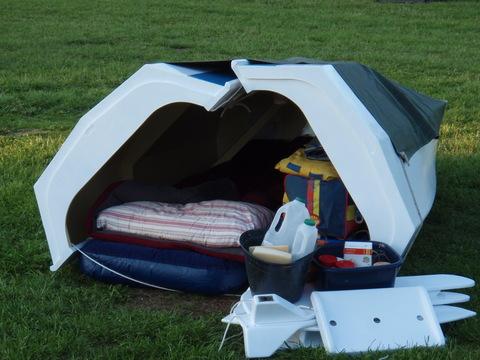 But: But:
1. She’s too long for my smallish garage. 2. The halves are easy to manage, but moving the other car onto a crowded street plus putting the halves together to get her on the car roof and the result is another struggle pitting man against gaps and gravity. 3. She is moderately tender regardless and with the half height bulkheads separating the two halves and other interior woodwork, trying to sleep aboard presents problems. 4. Looking for simplicity of design, ‘Curvy Mabel’ has at least fifteen feet (30%ish) less ‘stitch and tape’ seam than ‘Octavia’ and similarly around thirty feet (40%) less than your planned hull.* 5. Taking the other factors into account, I don’t want to ruin her ‘tremendous transom’ and lettering with anything as complicated as a rudder. Without one she won’t take the Pedyuloh and I fully intend to face forward at all reasonable costs. Ooooh; picky! 6. Actually (thinking primarily of outriggers, but anyway), anything extra that has to be clipped-on, sticks-out, needs repositioning, or otherwise complicates the basic machinery, will catch on/under/over/behind/in-front of things, break, trip you up and generally make the sort of confounded nuisance of itself that only inanimate objects can truly manage. I love tumblehome:  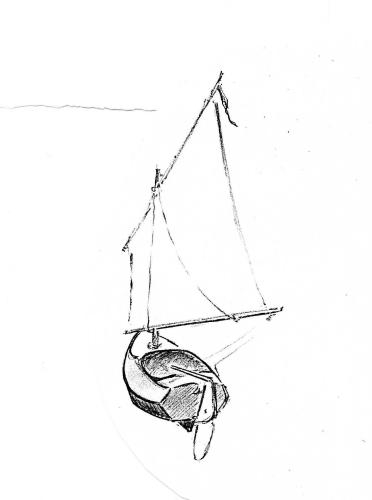 But it will tend to aggravate the requirement for outrigging the rowlocks, whereas flaring the sides minimizes the problem. No, not rebuilding to achieve a wider transom, I was merely trying to fit a useful width within the parameters of my aesthetics. This is meant to be an intellectual discussion on design, though I agree we all know what we’re actually doing is egging each other on. In regard to your design, if you are finding the rowing position very far forward and pushing the bow down when carrying a passenger, then you must have a reason for not moving the passenger further aft instead? I am assuming you’re aiming for around sixteen feet LOA, but can you tell us the actual figure and her beam? Or have I missed them somewhere earlier? Comparing my two, the new boat will be a foot shorter at 14’ 9” and three inches wider at 3’ 9”; there is a tad of extra volume in the new hull to provide stability for camping aboard and carrying capacity on the shorter LOA. Here is a diagram of the maximum beam cross-section of ‘Octavia’ drawn inside that of ‘Curvy Mabel’: 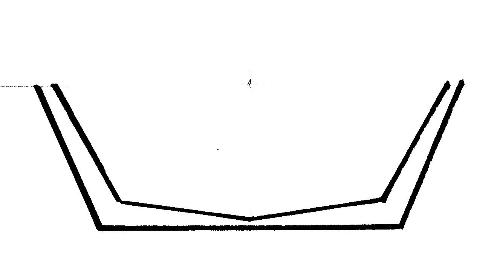 In fact it is crossing my mind to flare the sides out to increase the beam to 48 inches if I can get away with it, to improve the span between the rowlocks and it will also put more of Octavia's curve in Mabel. Next Brian, it’s fine to ask; the problem is how to stop me droning on. Eric and Graham are absolutely right when they say that you can’t produce a curve throughout the bottom of the boat, which would make the curve ‘compound’. As you are probably aware, this means it curves in two directions at once – something ply doesn’t really do. That is actually one of the major points of the ‘Premise’ design. It’s a ‘Flattie’ with the faults ironed out of it using ‘simple’ curves. The trick is that a ‘simple’ curve does not have to remain constant, either in direction, or radius and if you change those two parameters as the shape progresses it is possible to deceive the eye and even the water into thinking that it is being presented with a ‘compound’ shape. Eric’s ‘straight’ red lines pictured all over my upturned hull above, demonstrate the principle very well. I think the most beguiling examples are actually the cuddies on both ‘Polly Wee’ and ‘Tit Willow’. There are some ‘chines’, but an awful lot of very variable ‘simple’ curves thrown into a small space making them look much more spherical than the actually are: 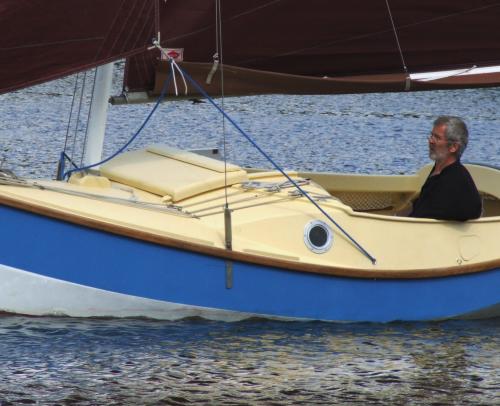 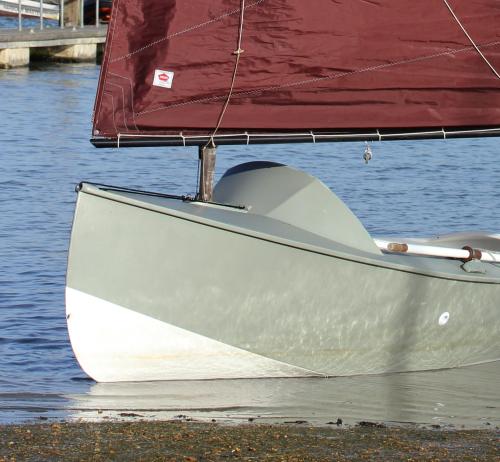 In regard to handling, I don’t think you would find ‘Polly Wee’ would let you down at all. Having been built that narrow for ‘bollard-avoidance’ reasons, she is tender, but the longer I sail her, the more she and her water ballast have proved that in extremis (and it hasn’t been very yet) she actually much prefers to be upright. And as Graham pointed out, flat bottoms also prevent spilling the drinks when lurking on the mud; a fact that applies to sleeping-bagged crews as well. You would be welcome to try – I’ll let you know next time I’m coming down to Keyhaven. She moves along well and when beating, that deep chine, with the sharp forefoot, seem to hold her upwind like nobody’s business. I do think you were unlucky with the Raid41. Incidentally, I don’t see how the main on ‘Brol’ can roll-reef round the mast with a pocketed batten that is angle back from the tack like a captive sprit? The lower forward end would jam almost instantly. And finally Paulie, it looks like a stretched ‘Premise’ as that was the promise Yippee-kiyay, brother duckers…. Gerontius (Why Gerontius? He had a dream, didn’t he?) |

|
Paul H (admin) |
Re: The Perfect River Raid Boat (PRRB)
|
|
Excellent post CW!
What Chris does so well is exploit in a creative way what is known as a "ruled surface". You can bend ply into a myriad of complex shapes if it is always flat-ish in one direction. Slide a ruler along your curvy ply hulls and you will understand - at any point you can fit a ruler approximately flush with the ply; just like the red lines that Eric drew. -Paul |

|
Chris Waite |
Re: The Perfect River Raid Boat (PRRB)
|
|
Plus ca change
The weirder it gets; Eric has just whispered in my ear (cyberously, of course) that the diagonal batten/sprit on 'Brol' is actually sufficiently flexible that as you rotate the mast, so it rolls the sail up while forming a helix of its own that, scaling the mast like honeysuckle, would not disgrace the DNA of old Albert Einstein himself.... Bring back the hollow log and a stick, I say Gerontius |
|
|
In reply to this post by Chris Waite
Oh CW, what amusing messages we have here these days, I cant match your wit and your boats are lovely shapes too. I especially like the shape of 'Titwillow'. What is Premise, is that similar to Titwillow? And what is this Raid41 that people seem to think so bad.
The use we have in mind for our proposed boat is day or part day trips, typically on Plymouth sound or round the corner to the Yealm and only during calm spells. I dont see it as a PRRB since it is a very conventional rowing boat so you cant see where you are going, a real difficulty on a narrow river, although a second crew and large rudder certainly helps. Mind you, if the boat actually gets built I am sure we would bring it to some HBBR river trips. Also, I dont really like the term 'raid' used to describe the peaceful HBBR/DCA outings that are so far removed from murder looting and other somewhat antisocial behaviours. Perhaps too late to change that now though. I think your proposed boat could well be a PRRB, if there is such a thing. It would be great to face forward, but for myself, I think rowing appeals more than peddalling, I know that I prefer it to paddling a canoe. Maybe that is only because it is what I am most used to though, we have done a lot or rowing of the 'grey boat' over the years. Timmo's boat is obviously excellent for river trips and I am sure your one could be just as good if you can get the pedalyuloh to work as well as the Hobbie thing, perhaps you already have. I guess that since you are talking about widening the beam for the rowlocks you want to be able to row as well as pedal. I agree that being a able to sleep on board is a huge advantage for the HBBR river trips, on the Kennet trip people seemed to be constantly anxious about where we were going to find somewhere to stop and camp without upsetting land owners. I think that knowing that you can tie up or anchor almost anywhere makes for peace of mind. Length of my proposed boat is 15feet, limited by our desire to have a reasonably portable boat to go on the car roof or to manually wheel down to the local beach with a simple trolley, also not to take up too much space stored in the garden. The overal beam without the outriggers is currently drawn at 860mm with a waterline beam of 724mm with two on board and 640mm with one on board, but those numbers could change only too easily since with a computer drawing program it is relatively easy to change one dimension and semi automatically adjust everything else to suit. This is called 'parametric modelling' and is one of the main advantages of useing a computer to do drawings, although not all drawing programs provide the capability. I havent actually done any calculation of lateral stability yet, I have just drawn something a bit wider at the waterline (hence more stable) than a racing rowing skiff, but not too much wider since we do want it to row nicely on fairly calm water. I am not knowledgable about rowing boats, so I realise that I am guessing, that's what some of the older engineers do but dont admit to it untill they have retired. Younger engineers arn't allowed to guess, they have to follow codes of practice. I guess that medics dont guess either, hope not anyway. Re. the outriggers for the rowlocks, I have been reading on one or two websites about the ideal spacing of rowlocks (I learnt that its called span) and the best height from the rowing thwart to the rowlocks etc. Interestingly, acording to those web sites, the rowing setup on the 'Grey boat' happens to be just about perfection, pity the boats a bit heavy for rowing! The lead centreboard and the ten gallon water tank probably dont help much. However, I dont want to duplicate the hull proportions of the grey boat, I want something much more slender and graceful, if only to keep the weight down and to allow for the possiblity to wheel it down the pavement through the village (although we dont have traffic bollards, the lanes and pavements are not wide, also for the last bit down to the beach there is a choice of going down some steps or through a gate that is only about a metre wide). So outriggers seem to be the only option and they have to be easilly removable/foldable for storage and for coming alongside quays etc. I did a bit of a design study on folding outriggers yesterday, in response to Chris P's sugestions, might write about that separately. Incidentally, I recall that you designed Polly Wee to wheel between two traffic bollards, I wonder if actually do that now the boat is finished? With my proposed boat I am thinking in terms of wheeling it down to the local beach, but having a car and an national trust membership for the car park at the beach I suspect that we wont actually do that very often, if at all. Why not balance the boat by moving the passenger further aft rather than moving the rower further forward? Well, my thought was that conventional wisdom says that you dont want significant transom immersion, also you dont want the bottom of the transom to be much above the water or you are 'wasting' boat length with unnecessary overhang. So, that means that as you add load to the boat it needs to 'pivot' about a line just below the bottom edge of the transom. That means that the centre of gravity of the boat has to move forward as the load increases. Since for this kind of boat, the persons on board weigh much more than the boat itself, the centre of gravity of the boat is not far off the mid point between the two persons. Moving the aftmost person (probably, but not necessarily, the passenger) aft is counterproductive since you want the centre of gravity to move forward as you add weight to the boat. From this point of view a 'wine glass' transom offers an advantage since you can probably allow it to immerse a bit without too much ill effect, perhpas that is why so many rowboats that are intended to carry an optional passenger do have that style of transom. However, a wineglass transom does not give the pitch stability benefit that you get with a flat bottom transom. John |
|
|
If your are researching folding riggers, you may like to look at these on the Echo Rowing Skiff. They work well in the context of a lightweight single, in that they fold and are used for carrying the boat, perhaps not so well for a larger cruising rowing boat that you may well be aboard when you want to fold the rigger.
http://www.echorowing.com/images/FoldingLorna.MPG http://www.echorowing.com/video.htm Brian |

|
Chris Partridge |
Re: The Perfect River Raid Boat (PRRB)
|
|
In reply to this post by John P
>>>>>The overal beam without the outriggers is currently drawn at 860mm with a waterline beam of 724mm with two on board and 640mm with one on board, but those numbers could change only too easily since with a computer drawing program it is relatively easy to change one dimension and semi automatically adjust everything else to suit.
This is actually rather important in a rowing boat. The boat is going to sit more than 3 inches deeper in the water when you have a passenger aboard. This means that the rowlocks are going to be closer to the water, so geometry dictates that the blades are higher and the handles are lower, making it more difficult to row without clipping your knees. You can cope with this in several ways: 1) Mount the rowlocks higher (but that means the handles will be uncomfortably high without a passenger). 2) Make the rowlock adjustable (complex and difficult if they are to take the load). 3) Make the boat a bit beamier. Oh the complexity of designing a boat intended to cope with lots of different uses/loads/sea conditions/weather/horoscopes..... |
|
|
Quote "This is actually rather important in a rowing boat. The boat is going to sit more than 3 inches deeper in the water when you have a passenger aboard. This means that the rowlocks are going to be closer to the water, so geometry dictates that the blades are higher and the handles are lower, making it more difficult to row without clipping your knees.
You can cope with this in several ways: 1) Mount the rowlocks higher (but that means the handles will be uncomfortably high without a passenger). 2) Make the rowlock adjustable (complex and difficult if they are to take the load). 3) Make the boat a bit beamier. " Does this mean that it is a benefit for John's design in that the aft rowing position is for single person aboard use and the forward rowing position is dedicated to rowing with two aboard, so the aft position can be optimised for the load waterline with one aboard and the forward position optimised for the deeper immersed situation with two aboard? No need to adjust either? Brian |
|
|
In reply to this post by BrianP
A little more on Brol.
Gilles Montaubin has kindly replied to my e-mail asking if he planned to release plans in the future for Brol. He replied that he does intend to release plans once testing is completed. A couple more pictures. One confirming the sails do indeed furl around the mast when rowing. This method does leave a very clean deck and promotes sailing and rowing as conditions allow. 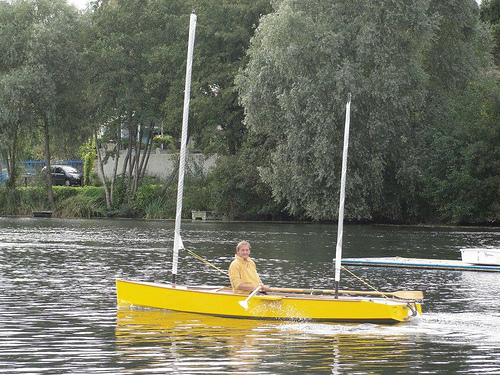 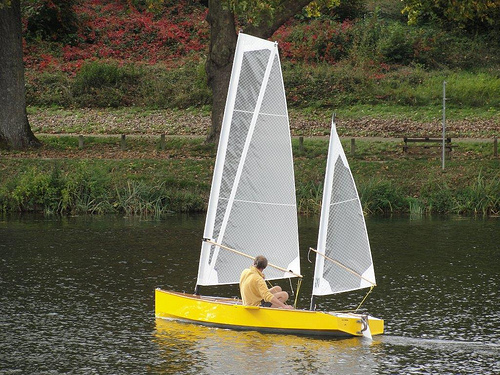 Brian |

|
Paul H (admin) |
Re: The Perfect River Raid Boat (PRRB)
|
|
It looks to me like he has copied the Windsurfer sail concept:
Efficient high aspect ratio main, the head catches more wind (pause for seasoned river sailors to laugh) but twists to reduce power in a gust. Trust me - it works. Battens to hold the sail shape? Not sure from the pictures. Wishbone style clamp to the main? There is a tell-tale gap in the luff tube, where a wishbone would clamp firmly to the mast. Although he has a "half-wishbone" aka boom. -Paul |

|
Chris Waite |
Re: The Perfect River Raid Boat (PRRB)
|
|
In reply to this post by John P
Ah, John Perry!
This is why I am so fond of the HBBR – it provides the opportunity to dream the long winter evenings away with like minded madmen and meet for magic moments in the summer when all the desires of our various childhoods can be acted out; a perfect solution to life in fact…. Pity about reality, really I’m glad you like ‘Tit Willow’; I have to say of a lifetime of having affairs with a motley fleet of tremendous sailing boats, she is probably the most scrumptious of them all – that’s what I whisper to her, under her cover and pat her on the stem, anyway. The Premise? Those of you who have heard this once, or twice before are excused the next two paragraphs. In the never ending quest for perfect simplicity, I was after a flat bottom boat providing reduced total seam length to minimize building requirements and to stay upright on the mud when the tide went out. There are problems with such boats in that they are generally not normally renowned for their seaworthiness, or beauty and particularly that they slam in a seaway. Two of the most famous examples that manage to avoid this are the Thames Barge and the Gloucester or Grand Banks Stacking Dory, so I set about taking what I consider are the best features of each and combining them – that was the notion, the ‘Premise’. I chose the flared sides and sweeping shear of the dory. Then added the vertical ends (to maximize LWL), softened forward chines (to stop the slamming) and tidy transom of the barge. Next, I threw in a large dollop of artistic licence, (all right, ‘free rein’ then), allowing me to maintain the single chine each side, simplify the transom, (raked for aesthetics and drawn to reach the working waterline) and gave it a mysterious retrousse canoe stem as it has connotations of Vikings and Hobbits and the like. Working from those parameters, it can be made any length, beam and hull depth that suits the owner’s purpose. I do not hold with the oft quoted idea that you cannot enlarge, or shrink a particular hull shape. “Tosh!” I say and it was first drawn as a twenty four foot gaff cutter with standing headroom: 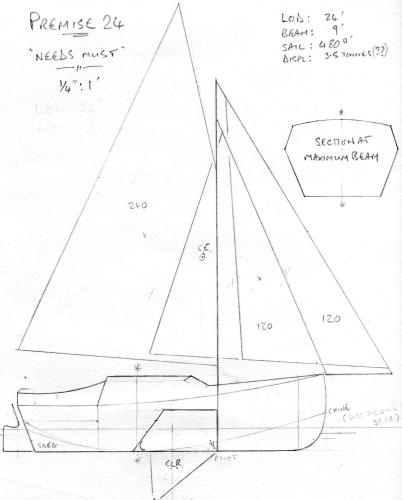 Which, (with a little deepening of the transom to allow for relative reduction in ballast), became a half scale prototype:  While making use of the experiment to produce a small singlehanded Raid Dinghy. My understanding is that the term ‘Raid’ in our context has come to refer to a Competitive, Camping Cruise in Company under Sail and Oar. Oh, all right then and ‘Paddle’ as well. Wikipedia has this to say about it: http://en.wikipedia.org/wiki/Raid_%E2%80%93_A_sail_and_oar_adventure And concurs with my intended next statement that English is a living language and the original dastardly meaning has been subsumed by a cuddly modern counterpart. I don’t know how ‘bad’ or otherwise the ‘Raid41’ was, though I note it is described as an “experimental design, now discontinued”: http://www.storerboatplans.com/raid41/raid41.html https://www.google.co.uk/search?q=raid+41+boat&tbm=isch&tbo=u&source=univ&sa=X&ei=zR11UvPvCInX0QXQs4CQDg&ved=0CEQQsAQ&biw=1280&bih=617 Brian may care to comment further. Next John, it’s actually a great shame we did not get you onto this site a while ago as one of the major topics of conversation has always been, whether to wear your canoe, see where you’re going and worry where you’ll stop, or to be able to stop anywhere and have enough room to camp aboard, but only ever see where you’ve been. Thus the preoccupation with Hobie Mirage Drives – excellent but expensive and requiring an obtrusive well; fore-view mirrors – preoccupying, I’ve tried; forward facing oar systems – fiddly; my Pedyuloh – Heath Robinson ( http://en.wikipedia.org/wiki/W._Heath_Robinson ) and even cameras and screens – why take expensive, complicated electronics to water, when a mirror will tell you the same thing? I agree with you, rowing is a delight; ramming banks, trees, swans, oncoming and moored narrow boats and not being able to admire the passing scenery – for me a major reason for being there, is a complete pain in the nethers. ‘Curvy Mabel’ will have a Pedyuloh, oars and as Graham has mooted, a large golf umbrella for downwind work, as nothing else spreads and furls that much canvas so rapidly and conveniently and stows so unobtrusively. Now you see it; now you don’t I have my eye on a large garden umbrella, in elegant green with black stripes, lurking within the confines of the family. Revolting pattern, though it should enable me to creep up on those herds of unsuspecting zebra that shelter under the mottled shade of the forests lining our inland waterways. Thanks for the dimensions of your design John, it gives me a better idea of how the boat will turn out. I do my designing using my on-board computer, usually as part of my Insomnia Unlimited Programme and then leave the ensuing cardboard model around to encourage me as I catch glimpses of it while pottering about the house. Almost all the measurements are very simple; taking my lead from the size of a sheet of ply and working as far as possible to the nearest three inches, if I can get away with it. I’ve made one or two concessions – the bit about the sides being sixteen inches and the floor thirty-two inches – merely because that adds up to four feet – that ply board again. Metric measurements are very useful for calculating stuff, but they are fuffing fiddly, hard for an old goat to imagine and do not have the human element that makes feet and inches so cuddly. I’m interested that you believe the medical profession does not guess. You’ve never heard the saying “Six Doctors, Seven Opinions” then? Two thoughts on rowlocks, first I love the expression that Tony Waller produced on being asked the distance aft of the seat that the rowlock mounts should be – “One foot from bollocks to rowlocks”; note, 'one foot', not 'three hundred and four point eight millimetres'. The next involves Chris and Brian’s thoughts on raising the forward mounts to allow for two PoB. ‘Curvy Mabel’ has a rising shear-line forward; like her flared sides, this will tend to move the mounts nearer their ideal position. In the interests of simplicity I am determined to try and avoid outriggers, though I might need the forward rowlock mounts on small hinged flaps. The bollards; ah yes, the bollards. I’d love to have spent the summer wheeling the boat between the bollards, however life has been coming the other way with sufficient force and speed to ensure that that dream has remained pretty much in the pipe. I did a few brief trials to set up the Pedyuloh in the Spring and amazingly did it for real and spent a couple of hours or so, the other side of the pass, just yesterday. Does that count? Incidentally, she is not actually finished; there are a few more evolutions to come yet. Water touching transoms and LWL. It’s a good question, isn’t it? As previously indicated my boats have skegs aft – if a skeg is showing under the transom, does the water count this as LWL, or not Anyone know? CW |
|
|
Quote "I have my eye on a large garden umbrella, in elegant green with black stripes, lurking within the confines of the family. Revolting pattern, though it should enable me to creep up on those herds of unsuspecting zebra that shelter under the mottled shade of the forests lining our inland waterways."
Have a look at this nice video for sailing canoes racing in Bremen this summer. My friend Axel sent me the link. He built the Hugh Horton Bufflehead sailing canoe , and is shown winning the race. However Chris, note the rig used downwind from about 35 seconds. The folding kayak using an umbrella seems to be going about the same speed as everyone else. I though he would furl his rig at the bottom mark, but he even tries upwind with the umbrella. The canoe in second place is a UK produced Solway Dory Egret and Solway Dory rig which has been very popular with the open canoeists taking up sailing. Have to say, I really enjoyed seeing Bufflehead under sail, first time I have seen her in action. She is a very fine sailing canoe indeed and very good two person paddling kayak as well. 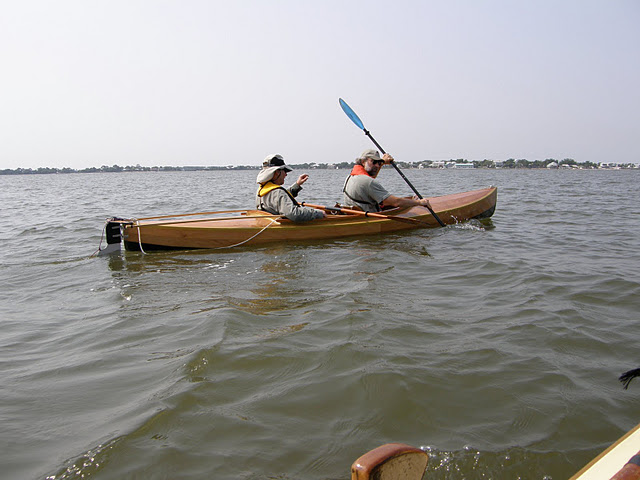 https://www.youtube.com/watch?feature=player_embedded&v=Ga7Ot0CSzdI Brian |
|
|
In reply to this post by John P
"Why not balance the boat by moving the passenger further aft rather than moving the rower further forward? Well, my thought was that conventional wisdom says that you dont want significant transom immersion, also you dont want the bottom of the transom to be much above the water or you are 'wasting' boat length with unnecessary overhang."
I see your point - reduce wetted surface area - but if the flat bottom plank(s) are only just above the LWL with either one or two people aboard you'll find in practice that at speed the stern wave will rise up and be in contact with this flat area anyway. A problem with letting the boat trim down at the bow when two are aboard - particularly if there's no skeg (although I note there's a rudder) - is that the centre of lateral resistance moves forward making the boat directionally unstable. A bit like a dart with feathers at the front instead of the back. It might also be that arranging the seats on this principle puts the two people further apart than they might be. The distribution of two heavy weights (people) in such a light boat will have a big effect on pitching, although as you say, the flat bottom transom will provide pitch damping. I suppose in theory the boat will pitch about a point further aft than if it were a double ender (the rower will go up and down more than the passenger [and again, the further you are apart {nearer the bow} the more the rower will go up and down]), but in practice I don't know if this will make much difference. As in most areas of boat design it's a compromise with a few things to weigh up. One thing I don't think you mentioned is the flat aft run's ability to plane when rowing with following waves, but again, skeg recommended. All IMO. John |

|
Chris Partridge |
Re: The Perfect River Raid Boat (PRRB)
|
|
>>>>>>As in most areas of boat design it's a compromise with a few things to weigh up. One thing I don't think you mentioned is the flat aft run's ability to plane when rowing with following waves, but again, skeg recommended.
John, could you enlarge on this? How can a rowing boat plane in following waves? I've managed to surf down following waves quite a lot but never planed.... |
|
|
Hi Chris. Is there a difference? When you say "surf" what distinguishes that from planing? After all there aren't many displacement surf boards around. :-) But I guess it depends on the speed of the wave - if it's slower than the max displacement speed of the boat, no, it won't be planing; but a wave travelling faster than (say) 5 knots is going to make the boat plane - or leave it behind. Do waves travel faster than 5 knots? Well they certainly do in open water. Were the waves that you surfed on travelling faster than you could row? That's been my experience. John On 09/11/2013 22:44, Chris Partridge
[via UK HBBR Forum] wrote:
>>>>>>As in most areas of boat design it's a compromise with a few things to weigh up. One thing I don't think you mentioned is the flat aft run's ability to plane when rowing with following waves, but again, skeg recommended. |

|
Chris Waite |
Re: The Perfect River Raid Boat (PRRB)
|
|
In reply to this post by BrianP
Lovely day
So to satisfy my own curiosity, if none else's, I thought I'd get out the green and black, stripey umbrella, as mooted above for a sail. Having measured one of the spokes before unfurling the beast, I was going to get all smart-butt and Pi-'r'-squared, but lo and behold: 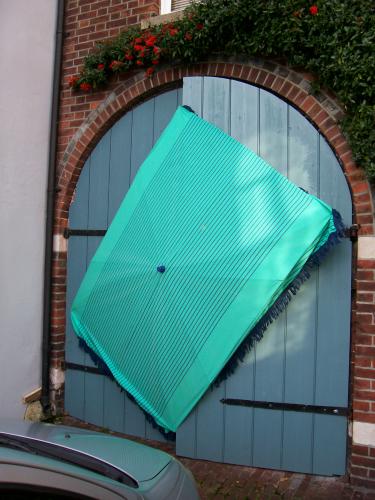 ....it's rectangular; and quite heavy, as well as being garish in the extreme. It's also around thirty square feet, excluding the fringe, which probably doesn't count; so the next question is, how do you reef an umbrella? I suppose the answer is to substitute an ordinary golf umbrella and then on down, through a black city-slicker's one, to a lady's folding version and ending up with one of those little jobbies You find in a cocktail Gerontius |
|
|
This post was updated on .
An interesting week for new designs. Three in total, one a small proa for Chris to look over, one a lightweight sail and oar boat by Francois Vivier and the third a home build plywood version of the Hobie Island Adventure designed for long coastal Raids in the US.
Here's the fun car top beach proa http://www.clcboats.com/life-of-boats-blog/Introducing-the-Outrigger-Junior.html?jm=1 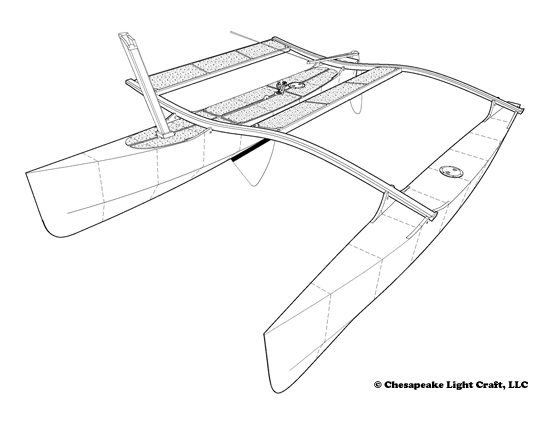 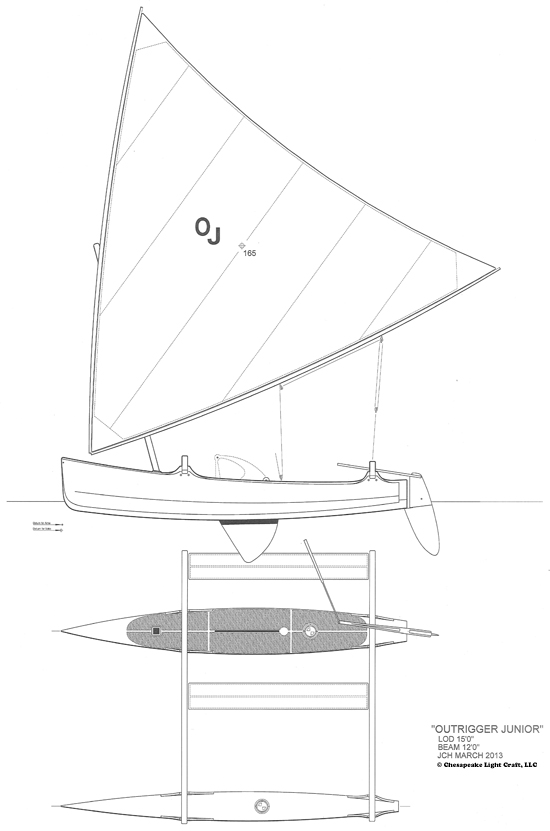 Francois Vivier has drawn a beautiful lightweight sail and oar craft. https://www.facebook.com/francois.vivier.architecte.naval?hc_location=timeline 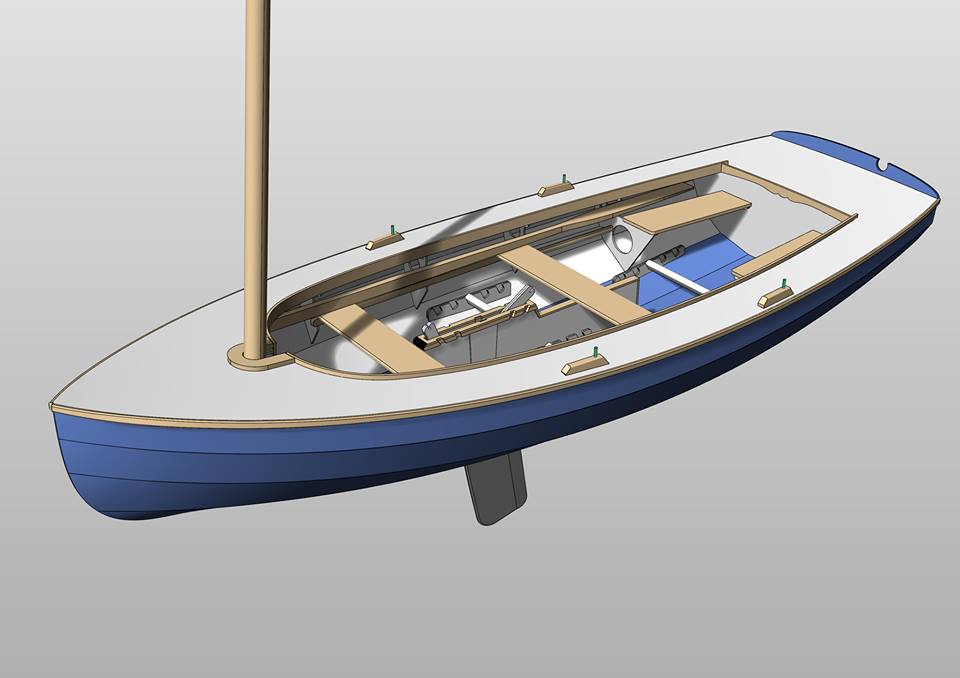 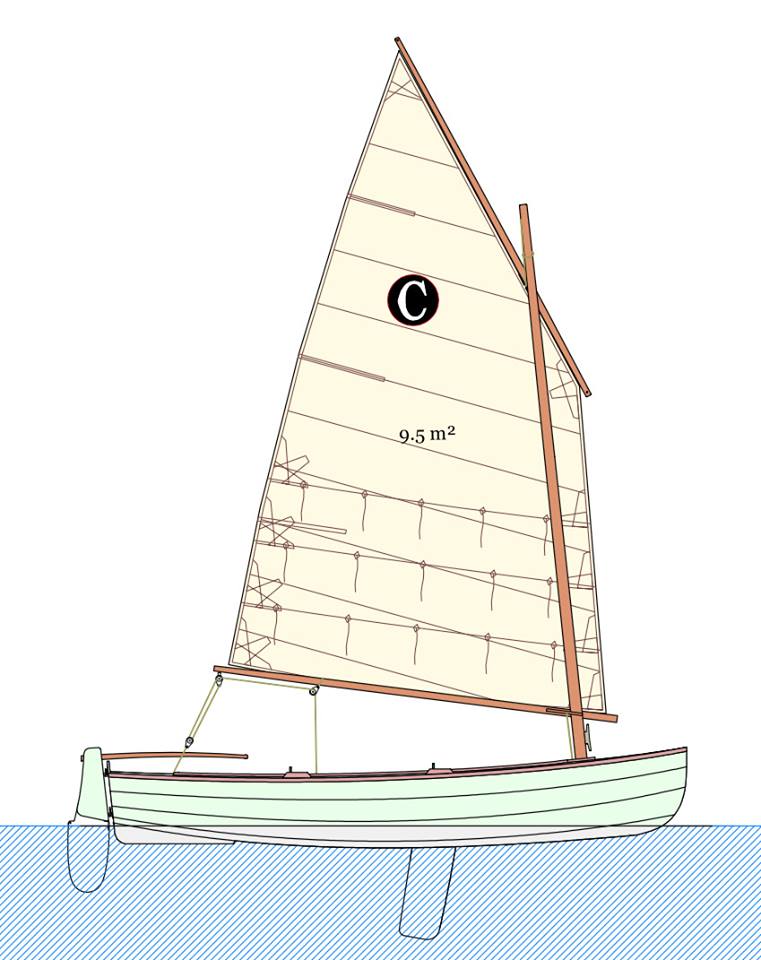 Its a CNC stitch and tape design, ideal for Alec Jordan to cut a kit since he is has an agreement with Vivier now. The full size printed mylar sets from Vivier are so expensive it will be much more cost effective to have a kit cut. 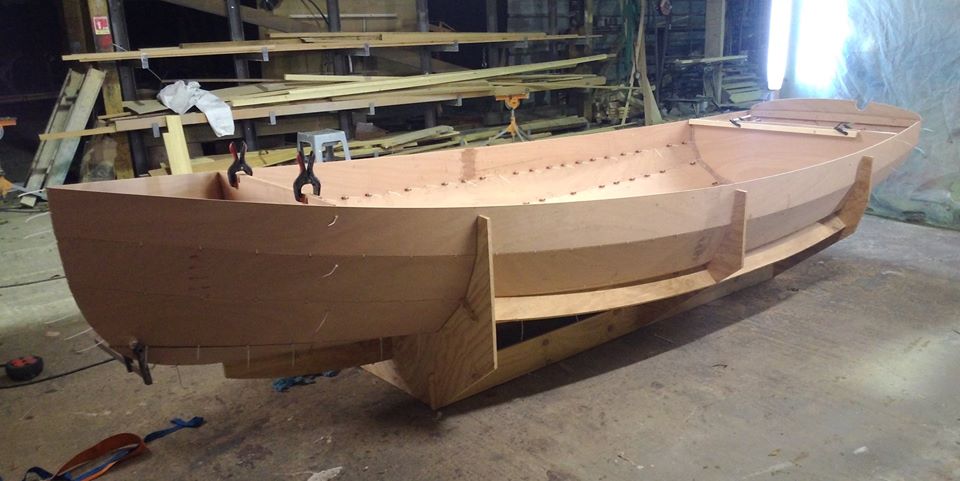 Having watched the Hobie Adventure island working it's way through the moorings, it's clear that a plywood version could be drawn that would be lighter, more seaworthy and much less cost. Here is just one such design which utilises the Hobie rig and very clever and quick to use, folding amas. http://sailnaway.blogspot.co.uk/2013/07/new-ec-design-rolled-out.html 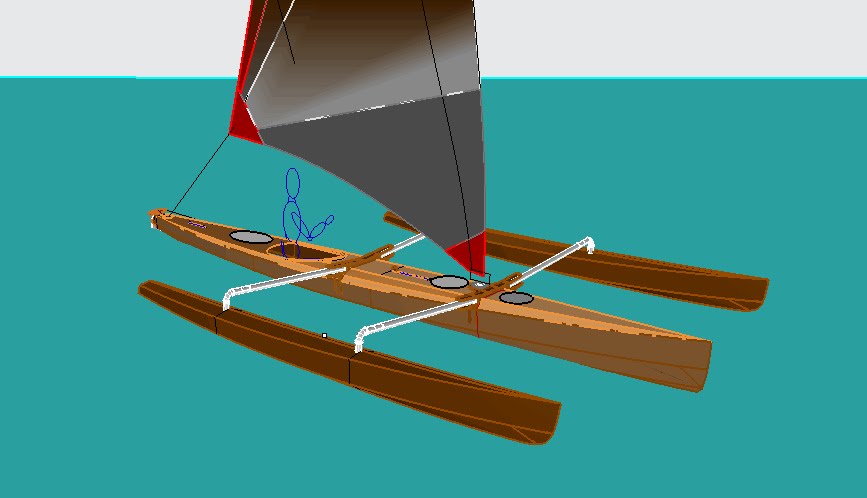 Build blog here http://sundance655.blogspot.co.uk/ Brian |
|
|
Hi Brian The CLC proa looks good. I've always liked proas. And I still fancy a cat before I get to old. Not so sure about that tri, but I'm not a good judge. It's hard to see what sort of sail control it has. Just a sheet going to the clew. No boom? I take it the boat is a tri so that it can be paddled? Good idea. I couldn't see the Vivier boat as it's a Facebook link. I don't do Facebook. Thanks for passing on the enquiry about the rowing boat. I sold a set of plans - £50. I'm just upgrading the files for cnc cutting before sending them. Lyme Regis launch day tomorrow. I'm to busy to go unfortunately. John On 08/12/2013 15:27, BrianP [via UK
HBBR Forum] wrote:
An interesting week for new designs. Three in total, one a small proa for Chris to look over, one a lightweight sail and oar boat by Francois Vivier and the third a home build plywood version of the Hobie Island Adventure designed for long coastal Raids in the US. |
|
|
Glad to hear you sold a set of plans.
Try this earlier link http://www.chasse-maree.com/images/stories/complements_web/237/Naviguerleger/CREIZIC.pdf |

|
Port-Na-Storm |
Re: The Perfect River Raid Boat (PRRB)
|
|
In reply to this post by BrianP
Three very interesting designs Brian.
I like Vivier's sail-and-oar boat a lot, and the Tri. I met a guy on The Gower this summer, who I got chatting to. He was waiting for enough wind to launch his para-glider off the cliffs. When he wasn't doing that he sailed his Hobie Adventure Island along the coast. Seems to me that's exactly what it is designed for, reaching along on long tacks camping on deserted beaches along the way. Brilliant. He did say it was a bit of a brute to man-handle ashore, and reckoned he needed a Transit to Van-Top it. He didn't think an estate car would do it. Which seems to me a bloody good excuse to get that VW transporter I've wanted for a few years. So a ply version should be great especially if it's a bit more enclosed (drier) than the sit-on-top Hobie. Just have to get hold on one of those elusive Hobie-drives. Not a river boat though. Cheers Grum. |
|
|
Uh oh, this is dangerous. I have for some time had a nagging itch to build a Proa but untill now had not found the design that works for me. I had also spotted that new design from CLC and can’t wait to see it in action on the water.
I would rather it was a proper shunting proa where the ama stays on the windward side but it’s still a fine and fun looking bit of kit (but definitely not the PRRB). |
«
Return to General Discussion
|
1 view|%1 views
| Free forum by Nabble | Edit this page |
